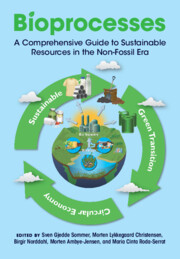Book contents
- Bioprocesses
- Bioprocesses
- Copyright page
- Contents
- Contributors
- Preface
- Acknowledgments
- Abbreviations
- 1 Introduction
- 2 Biomass
- 3 Sustainability, Circularity, LCA, and Governance
- 4 Conservation, Logistics, and Risk Analysis
- 5 Chemical Product Design
- 6 Chemical Processes and Modeling
- 7 Pretreatment of Biomass: Structural Modification, Preparation, and Fractionation of Biomass for Further Conversion
- 8 Separation Processes and Biomass Fractionation
- 9 Microbial Conversion
- 10 Thermochemical Conversion of Biomass
- 11 Basic Business Concepts and Cost Accounting and Analysis
- Glossary
- Index
- References
6 - Chemical Processes and Modeling
Published online by Cambridge University Press: 24 January 2025
- Bioprocesses
- Bioprocesses
- Copyright page
- Contents
- Contributors
- Preface
- Acknowledgments
- Abbreviations
- 1 Introduction
- 2 Biomass
- 3 Sustainability, Circularity, LCA, and Governance
- 4 Conservation, Logistics, and Risk Analysis
- 5 Chemical Product Design
- 6 Chemical Processes and Modeling
- 7 Pretreatment of Biomass: Structural Modification, Preparation, and Fractionation of Biomass for Further Conversion
- 8 Separation Processes and Biomass Fractionation
- 9 Microbial Conversion
- 10 Thermochemical Conversion of Biomass
- 11 Basic Business Concepts and Cost Accounting and Analysis
- Glossary
- Index
- References
Summary
A central part at biorefinery plants is the conversion of raw materials to the product of interest. The conversion process can be chemical or biological. The chemical conversion will be explained in this chapter and the biological conversion in Chapter 9. The basic principle for the chemical reaction process will be explained, including catalytic reactions, reaction kinetics, and mass transport
- Type
- Chapter
- Information
- BioprocessesA Comprehensive Guide to Sustainable Resources in the Non-Fossil Era, pp. 230 - 264Publisher: Cambridge University PressPrint publication year: 2025

